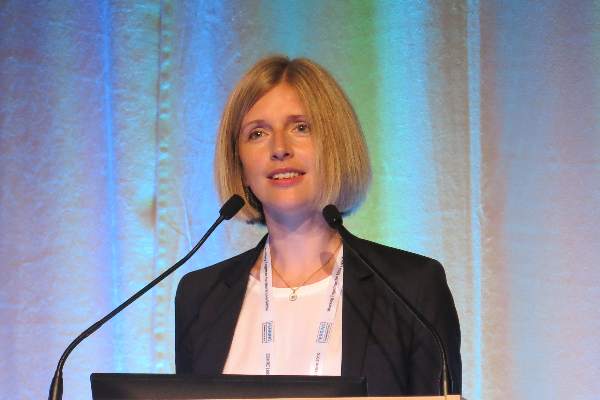User login
LISBON – Women undergoing assisted reproduction had similar pregnancy rates with gonadotropin-releasing hormone agonist and antagonist protocols, but less ovarian hyperstimulation syndrome with the GnRH-antagonist protocol in a large randomized trial.
Severe ovarian hyperstimulation syndrome (OHSS) was roughly halved with the GnRH-antagonist vs. the GnRH-agonist protocol (3.2% vs. 6.1%; P = .03), as were ascites punctures (0 vs. 2%: P = .001) and treatment changes due to risk of OHSS (5.7% vs. 10.3%; P = .006).
Hospital admissions for OHSS also favored the GnRH antagonist protocol (1.7% vs. 3.6%; P = .06), Dr. Mette Toftager reported at the annual meeting of the European Society of Human Reproduction and Embryology.
The exact impact of these protocols has been controversial following early reports that GnRH antagonists were associated with lower pregnancy rates.
Two 2006 meta-analyses yielded conflicting results, but were based on small heterogeneous trials that were not powered for OHSS nor pregnancy rates and were conducted in selected populations, said Dr. Toftager of Fertility Clinic, Hvidovre Hospital, Denmark.
The current noninferiority trial used few inclusion criteria – just age 18-40 years and first in vitro fertilization (IVF) or intracytoplasmic sperm injection (ICSI) cycle – to prospectively enroll 1,099 women and evenly randomize them to a classic short GnRH-antagonist protocol or a classic long GnRH-agonist protocol.
Women received a fixed dose of either recombinant follicle stimulating hormone 150 IU or 225 IU based on age (≤ 36 years vs. > 36 years) and were given the option to adjust the rFSH dose based on ovarian response at stimulation day 6.
The trial was designed to detect a 2.5% difference in moderate/severe OHSS per Golan OHSS criteria between the two groups, stratified by age, IVF center, and IVF/ICSI.
At baseline, the two groups were comparable in age (mean 32 years), cycle length (mean 28.9 days), and nulliparity (92.3%). The study included women with irregular cycles and polycystic ovary syndrome, who represented about 13% of each group.
Regarding stimulation, significant differences were found between the GnRH-antagonist and GnRH-agonist groups in total rFSH dose (mean 1,522 IU vs. 1,999 IU), days of stimulation (mean 9 vs. 11), and the number of aspirated oocytes (mean 8.5 vs. 10; P < .0001 for all), Dr. Toftager reported.
The GnRH-antagonist and GnRH-agonist groups had the same number of embryos transferred (mean 1.1 vs. 1.2), use of embryo freezing (50% vs. 53%), and number of frozen embryos (mean 3.2 vs. 3.4).
By all measures used, pregnancy outcomes were similar between protocols, she said.
The GnRH-antagonist and GnRH-agonist groups had similar clinical pregnancy rates (35% vs. 35.7%) and clinical pregnancies per embryo transfer (42.6% vs. 41%). There were similar results for ongoing pregnancy rates analyzed per randomization (25.5% vs. 26.4%), if patient started stimulation (24.8% vs. 24.0%), and per embryo transfer (30.7% vs. 29%).
During a discussion of the results, an audience member questioned the high FSH starting doses and suggested they may be the cause of OHSS. Dr. Toftager said the trial was designed in 2007 and that they now use lower FSH doses, but that starting doses were the same in both groups.
Another attendee asked whether OHSS rates remained statistically significant after controlling for the number of oocytes collected and the gonadotropin dose, which were significantly lower in the GnRH-antagonist group and hence, so was OHSS. That analysis will likely be conducted, but the data were just received days before the presentation, Dr. Toftager said.
Merck Sharp & Dohme sponsored the study. Dr. Toftager reported having no financial conflicts.
On Twitter @pwendl
LISBON – Women undergoing assisted reproduction had similar pregnancy rates with gonadotropin-releasing hormone agonist and antagonist protocols, but less ovarian hyperstimulation syndrome with the GnRH-antagonist protocol in a large randomized trial.
Severe ovarian hyperstimulation syndrome (OHSS) was roughly halved with the GnRH-antagonist vs. the GnRH-agonist protocol (3.2% vs. 6.1%; P = .03), as were ascites punctures (0 vs. 2%: P = .001) and treatment changes due to risk of OHSS (5.7% vs. 10.3%; P = .006).
Hospital admissions for OHSS also favored the GnRH antagonist protocol (1.7% vs. 3.6%; P = .06), Dr. Mette Toftager reported at the annual meeting of the European Society of Human Reproduction and Embryology.
The exact impact of these protocols has been controversial following early reports that GnRH antagonists were associated with lower pregnancy rates.
Two 2006 meta-analyses yielded conflicting results, but were based on small heterogeneous trials that were not powered for OHSS nor pregnancy rates and were conducted in selected populations, said Dr. Toftager of Fertility Clinic, Hvidovre Hospital, Denmark.
The current noninferiority trial used few inclusion criteria – just age 18-40 years and first in vitro fertilization (IVF) or intracytoplasmic sperm injection (ICSI) cycle – to prospectively enroll 1,099 women and evenly randomize them to a classic short GnRH-antagonist protocol or a classic long GnRH-agonist protocol.
Women received a fixed dose of either recombinant follicle stimulating hormone 150 IU or 225 IU based on age (≤ 36 years vs. > 36 years) and were given the option to adjust the rFSH dose based on ovarian response at stimulation day 6.
The trial was designed to detect a 2.5% difference in moderate/severe OHSS per Golan OHSS criteria between the two groups, stratified by age, IVF center, and IVF/ICSI.
At baseline, the two groups were comparable in age (mean 32 years), cycle length (mean 28.9 days), and nulliparity (92.3%). The study included women with irregular cycles and polycystic ovary syndrome, who represented about 13% of each group.
Regarding stimulation, significant differences were found between the GnRH-antagonist and GnRH-agonist groups in total rFSH dose (mean 1,522 IU vs. 1,999 IU), days of stimulation (mean 9 vs. 11), and the number of aspirated oocytes (mean 8.5 vs. 10; P < .0001 for all), Dr. Toftager reported.
The GnRH-antagonist and GnRH-agonist groups had the same number of embryos transferred (mean 1.1 vs. 1.2), use of embryo freezing (50% vs. 53%), and number of frozen embryos (mean 3.2 vs. 3.4).
By all measures used, pregnancy outcomes were similar between protocols, she said.
The GnRH-antagonist and GnRH-agonist groups had similar clinical pregnancy rates (35% vs. 35.7%) and clinical pregnancies per embryo transfer (42.6% vs. 41%). There were similar results for ongoing pregnancy rates analyzed per randomization (25.5% vs. 26.4%), if patient started stimulation (24.8% vs. 24.0%), and per embryo transfer (30.7% vs. 29%).
During a discussion of the results, an audience member questioned the high FSH starting doses and suggested they may be the cause of OHSS. Dr. Toftager said the trial was designed in 2007 and that they now use lower FSH doses, but that starting doses were the same in both groups.
Another attendee asked whether OHSS rates remained statistically significant after controlling for the number of oocytes collected and the gonadotropin dose, which were significantly lower in the GnRH-antagonist group and hence, so was OHSS. That analysis will likely be conducted, but the data were just received days before the presentation, Dr. Toftager said.
Merck Sharp & Dohme sponsored the study. Dr. Toftager reported having no financial conflicts.
On Twitter @pwendl
LISBON – Women undergoing assisted reproduction had similar pregnancy rates with gonadotropin-releasing hormone agonist and antagonist protocols, but less ovarian hyperstimulation syndrome with the GnRH-antagonist protocol in a large randomized trial.
Severe ovarian hyperstimulation syndrome (OHSS) was roughly halved with the GnRH-antagonist vs. the GnRH-agonist protocol (3.2% vs. 6.1%; P = .03), as were ascites punctures (0 vs. 2%: P = .001) and treatment changes due to risk of OHSS (5.7% vs. 10.3%; P = .006).
Hospital admissions for OHSS also favored the GnRH antagonist protocol (1.7% vs. 3.6%; P = .06), Dr. Mette Toftager reported at the annual meeting of the European Society of Human Reproduction and Embryology.
The exact impact of these protocols has been controversial following early reports that GnRH antagonists were associated with lower pregnancy rates.
Two 2006 meta-analyses yielded conflicting results, but were based on small heterogeneous trials that were not powered for OHSS nor pregnancy rates and were conducted in selected populations, said Dr. Toftager of Fertility Clinic, Hvidovre Hospital, Denmark.
The current noninferiority trial used few inclusion criteria – just age 18-40 years and first in vitro fertilization (IVF) or intracytoplasmic sperm injection (ICSI) cycle – to prospectively enroll 1,099 women and evenly randomize them to a classic short GnRH-antagonist protocol or a classic long GnRH-agonist protocol.
Women received a fixed dose of either recombinant follicle stimulating hormone 150 IU or 225 IU based on age (≤ 36 years vs. > 36 years) and were given the option to adjust the rFSH dose based on ovarian response at stimulation day 6.
The trial was designed to detect a 2.5% difference in moderate/severe OHSS per Golan OHSS criteria between the two groups, stratified by age, IVF center, and IVF/ICSI.
At baseline, the two groups were comparable in age (mean 32 years), cycle length (mean 28.9 days), and nulliparity (92.3%). The study included women with irregular cycles and polycystic ovary syndrome, who represented about 13% of each group.
Regarding stimulation, significant differences were found between the GnRH-antagonist and GnRH-agonist groups in total rFSH dose (mean 1,522 IU vs. 1,999 IU), days of stimulation (mean 9 vs. 11), and the number of aspirated oocytes (mean 8.5 vs. 10; P < .0001 for all), Dr. Toftager reported.
The GnRH-antagonist and GnRH-agonist groups had the same number of embryos transferred (mean 1.1 vs. 1.2), use of embryo freezing (50% vs. 53%), and number of frozen embryos (mean 3.2 vs. 3.4).
By all measures used, pregnancy outcomes were similar between protocols, she said.
The GnRH-antagonist and GnRH-agonist groups had similar clinical pregnancy rates (35% vs. 35.7%) and clinical pregnancies per embryo transfer (42.6% vs. 41%). There were similar results for ongoing pregnancy rates analyzed per randomization (25.5% vs. 26.4%), if patient started stimulation (24.8% vs. 24.0%), and per embryo transfer (30.7% vs. 29%).
During a discussion of the results, an audience member questioned the high FSH starting doses and suggested they may be the cause of OHSS. Dr. Toftager said the trial was designed in 2007 and that they now use lower FSH doses, but that starting doses were the same in both groups.
Another attendee asked whether OHSS rates remained statistically significant after controlling for the number of oocytes collected and the gonadotropin dose, which were significantly lower in the GnRH-antagonist group and hence, so was OHSS. That analysis will likely be conducted, but the data were just received days before the presentation, Dr. Toftager said.
Merck Sharp & Dohme sponsored the study. Dr. Toftager reported having no financial conflicts.
On Twitter @pwendl
AT ESHRE 2015
Key clinical point: Pregnancy rates are similar with short GnRH-antagonist and long GnRH-agonist protocols, but severe ovarian hyperstimulation is reduced with the short protocol in first IVF/ICSI-cycle patients.
Major finding: Severe OHSS occurred in 3.2% with the GnRH-antagonist protocol vs. 6.1% with the GnRH-agonist protocol (P = .03).
Data source: A randomized, controlled trial of 1,099 first IVF/ICSI-cycle women.
Disclosures: Merck Sharp & Dohme sponsored the study. Dr. Toftager reported having no financial conflicts.

